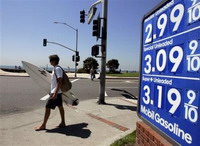Oil prices swoop down on worries of low consumer demand
Oil prices droped Friday as consumer inflation jumped, raising worries that demand could suffer.

Energy traders are concerned that rising inflation will cut consumers' buying power and reduce demand for gasoline and oil. They also worry that higher inflation means the Federal Reserve will stop cutting interest rates. Many analysts cite the Fed's recent rate-cutting campaign, and its role in depressing the value of the dollar against other currencies, as a major factor behind oil's rise this fall to record levels.
Earlier Friday, prices rose after the International Energy Agency boosted its oil demand forecast for next year. However, many analysts think the IEA, an adviser to mostly Western, industrialized nations, is overlooking signs that demand for crude is weakening.
"Usually the IEA underestimates demand but now I think they are overestimating demand," said Phil Flynn, an analyst at Alaron Trading Corp. in Chicago.
A separate OPEC report offered a mixed forecast, slightly raising the Organization of Petroleum Exporting Countries' global oil demand growth expectations for next year while saying the outlook for economic growth is worsening, particularly in the U.S.
Light, sweet crude for January delivery fell 99 cents to $91.26 a barrel by midday on the New York Mercantile Exchange.
Last month's 0.8 percent increase in the Consumer Price Index was led by gasoline prices, which jumped above $3 a gallon as oil was approaching $100 a barrel. Oil prices have risen this fall partly due to speculative buying by investors who see crude futures as a hedge against a weak dollar. Also, oil futures bought and sold in dollars are more attractive to foreign investors when the dollar is falling. The dollar strengthened on Friday, giving oil investors another reason to sell.
Analysts questioned predictions of higher demand growth next year by the IEA and OPEC, given recent signs that demand growth is falling. A recent Energy Department report lowered global oil demand predictions for next year, and recent Energy Information Administration inventory reports have shown demand growth is tepid at best. On Friday, the IEA reduced its demand growth expectations for 2007. Meanwhile, OPEC supplies are growing.
"Oil consultancy firm Oil Movements projected that OPEC oil exports ... will jump 460,000 barrels per day in the four weeks (ending) Dec. 29 ... or 400,000 barrels per day higher than in the same period last year," said Edward Meir, an analyst at MF Global UK Ltd., in a research note.
Other energy futures were mixed Friday. January gasoline futures fell 0.92 cent to $2.3652 a gallon on the Nymex, while January natural gas fell 16.4 cents to $7.029 per 1,000 cubic feet.
January heating oil futures rose 0.22 cents to $2.6169 a gallon.
In London, January Brent crude fell 35 cents to $91.77 a barrel on the ICE Futures exchange.
Subscribe to Pravda.Ru Telegram channel, Facebook, RSS!




